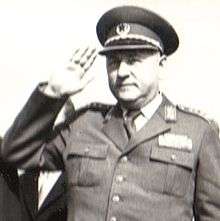Ivan Gošnjak
| Ivan Gošnjak Иван Гошњак | |
|---|---|
 Ivan Gošnjak, 1966. | |
| 2nd Federal Secretary of People's Defense of Yugoslavia | |
|
In office 14 January 1953 – 18 May 1967 | |
| Preceded by | Josip Broz Tito |
| Succeeded by | Nikola Ljubičić |
| Personal details | |
| Born |
10 June 1909 Ogulin, Austria-Hungary |
| Died |
8 February 1980 (aged 70) Belgrade, Socialist Federal Republic of Yugoslavia |
| Nationality | Croat |
| Political party | SKJ |
| Spouse(s) | Tea Gošnjak |
| Awards |
Order of Freedom Order of National Hero of Yugoslavia |
| Military service | |
| Allegiance | Socialist Federal Republic of Yugoslavia |
| Service/branch |
International Brigades Yugoslav People's Army |
| Years of service |
1936–1939 1942–1974 |
| Rank | General of the Army |
| Commands | Yugoslav People's Army |
| Battles/wars |
Spanish civil war World War II |
Ivan Gošnjak (Serbian Cyrillic: Иван Гошњак; 10 June 1909 – 8 February 1980) was a Croatian communist who held numerous important offices in Yugoslavia during and after World War II, serving as the Minister of Defence from 1953 to 1967.
Ivan Gošnjak was a carpenter by profession and joined the Communist Party of Yugoslavia in 1933. In 1935 Gošnjak was sent to Moscow and was enrolled for one year at the Lenin School where he also attended lectures by "comrade Walter", better known by his World War II-era codename Tito. In 1936 Gošnjak was sent to a military barracks in Ryazan where he was given the designation "Number 36", instead of his real name and was given military instruction before being sent as a volunteer to the Spanish Civil War in January 1937. A great admirer of Joseph Stalin, Gošnjak was appointed captain in the International Brigades. After the defeat of the republican forces in Spain, Gošnjak was detained in France in 1939. After the capitulation of France in 1940 Gošnjak escaped from the camp, going in 1941 to Germany as a worker. In Germany he used a fake passport, and in July 1942 returned to Croatia and immediately joined Tito's partisans.
As a Spanish civil war veteran, he was given command of all Croatian partisan units in 1943. Gošnjak was appointed as deputy commander-in-chief at the end of the war, a post which he held until 1950.
In 1946 Tito wanted to send him to complete his military studies at the Soviet Voroshilov Military Academy, but Gošnjak asked him for permission to stay in Belgrade and work in the Central Committee. Tito agreed and later appointed him as deputy Defence Minister (1950–1953). At the Fifth Yugoslav CP congress Gošnjak was elected a member of the Politburo and later was made a member of the Executive Committee (the new name for the Politburo), elected at the sixth (1952), seventh (1958), and eighth (1964) party congresses. In 1953 Gošnjak became Defence Minister, a post which he held until 1967 when he was replaced by General of the Army Nikola Ljubičić. In 1963 he was considered for promotion in rank General, but he was never promoted.
Stalin could never forgive Gošnjak for taking, as a former student of the Lenin School, Tito's side during the Informbiro period. At the Rajk Trial in Budapest (1949) General Gošnjak was accused "of having been a Gestapo agent from 1941 onward". But General Gošnjak and his comrade, General of the Army Kosta Nađ (who was also accused of having been a Gestapo agent), "were from 1941 to 1945 commanders of strategic units of the People's Liberation Army of Yugoslavia, and toward the end of the war commanded corps that dealt the Germans heavy blows."
General Ivan Gošnjak retired from active military service in 1974 and since then he was a member of the Council of Federation, and advisor body to President Tito.[1] He is buried in the Alley of Distinguished Citizens in Belgrade, Serbia.
| Political offices | ||
|---|---|---|
| Preceded by Josip Broz Tito |
Federal Secretary of People's Defense of Yugoslavia 14 January 1953 – 18 May 1967 |
Succeeded by Nikola Ljubičić |
See also
References
| Wikimedia Commons has media related to Ivan Gošnjak. |
- ↑ (Serbian) Ivan Gošnjak biography